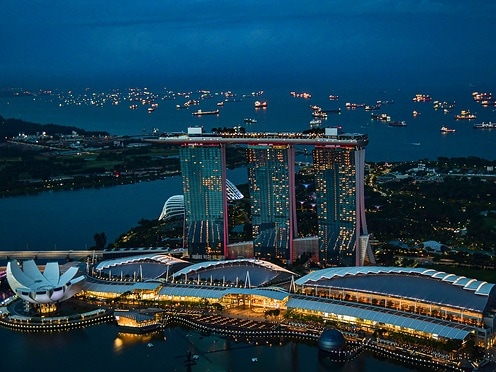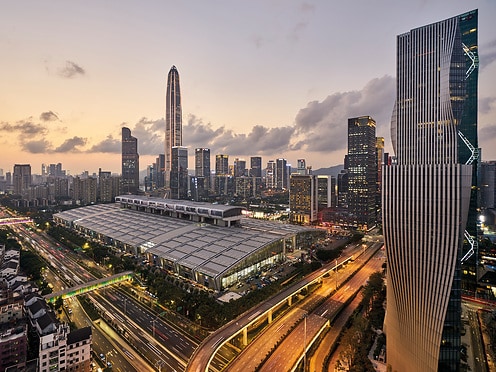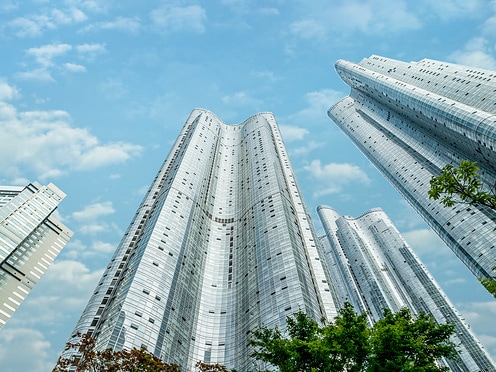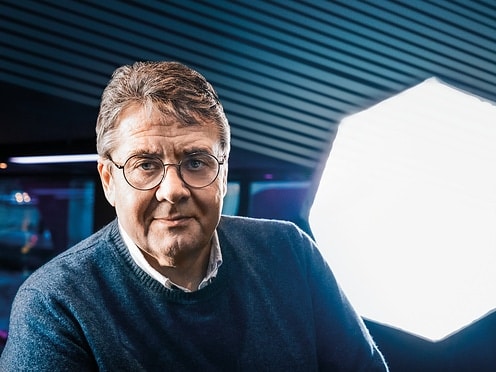Green infrastructure: Sustainable approaches for cities
This article features:
“Green infrastructure” is a key factor in improving the resilience of towns and cities to the megatrends of climate change and energy shortage. But how exactly does so-called green or green and blue infrastructure contribute to urban sustainability and resilience? In this article, we take a look at strategies, approaches and examples.

What do we understand by the term green infrastructure?
Green infrastructure encompasses a network of natural and artificial green space that is systematically integrated into towns and cities. These systems play a key role in enhancing biodiversity, promoting cultural identity, improving environmental quality, and meeting the technical challenges of water and air purification. Green infrastructure harnesses nature-based solutions as a sustainable approach. The quality of life in towns and cities is improved in this manner, while the resilience to environmental challenges is also strengthened.
Functions and advantages
As green infrastructure plays a decisive role in the sustainability and quality of urban areas, it makes a substantial contribution to human well-being. It also creates space for rest and social interaction and promotes mental health. Green infrastructure’s many functions help achieve the following goals:
Integrating the natural environment in the city
Promoting ecosystem services
Air purification
Filtering water and regulating temperatures
The advantages are manifold – green infrastructure…
… improves air quality in cities because plants filter out pollution and produce oxygen.
…promotes biodiversity by creating habitats for various plants and animals.
…shrinks “urban heat islands” through temperature regulation measures.
...provides recreational areas that improve the well-being of city dwellers.
…supports water management as rainwater is absorbed and filtered naturally and flood protection is provided for.

10 strategies and examples for implementing green and blue infrastructure
The effective implementation of green and blue infrastructure requires targeted strategies and the integration of proven concepts. These illustrate how utilizing a green infrastructure strategy can make towns and cities more resilient to environmental influences. It also shows how the quality of life of its residents can be continuously improved.
1. Urban forests and parks
2. Green roofs
In addition to thermally insulating buildings, green roofs promote biodiversity by offering birds, insects and small mammals with habitats. They manage stormwater by absorbing precipitation and relieve sewer systems in this way. Green roofs also play a role in improving air quality. As an urban greening factor, they also contribute to enhancing cityscapes aesthetically.
3. Restoring wetlands
By promoting nature recovery, cities can improve water quality with blue space whilst at the same time creating vital habitats for a variety of species. Wetlands also provide natural flood management while also reducing greenhouse gases. Blue space also provides valuable recreational areas that improve the mental and physical well-being of city dwellers.
4. Littoral zones
The restoration of natural spaces like river banks and shorelines promotes the stability of littoral zones and protects against erosion. As natural ecosystems return, local plants improve water quality as they filter stormwater flows. Additionally, they create important habitats for creatures on land and in the water. These green and blue spaces also provide attractive local recreational areas and increase the quality of life for local communities.
5. Permeable surfaces
6. Human-made wetlands
Blue green infrastructure such as artificial water ecosystems imitate the function of natural wetlands and offer efficient solutions for water purification. They act as biological water treatment systems, whereby green cover and microorganisms remove pollutants from water. At the same time, they create an important habitat for many types of animals and plants as well as providing a basis for research and education.
7. River restoration
The restoration of the natural course of rivers has multiple benefits. Not only are the water quality and landscape aesthetics improved but a marine environment is created that is conducive to the return of fish and other aquatic creatures. Nature recovery in rivers contributes to the resilience of cities to flooding as well as creating recreational and leisure areas for inhabitants.
8. Rain gardens
A rain garden is a specially planted garden that captures rainwater from roofs and paved surfaces. This green infrastructure also uses the natural filtration of the ground to remove pollutants. Rain gardens reduce drainage in the sewer system effectively and help replenish ground water. They improve not only urban biodiversity but also increase awareness about sustainable rainwater utilisation.
9. Urban farming
Growing food in urban areas promotes local food supply and helps to tackle climate change as shorter transport routes reduce our carbon footprint. Green infrastructure like urban gardens run by community groups and rooftop farming not only provide fresh produce but also support equitable access and promote awareness about healthy diets. They also make an important contribution to the development of urban green space.
10. Educational campaigns
Through targeted educational and public awareness campaigns, towns and cities can increase their inhabitants’ sensitivity to and understanding of the importance and environmental benefits of green infrastructure. These campaigns promote the active participation of local communities in environmental measures by planting trees or restoring wetlands for example. By directly involving citizens in projects in their local area, community spirit is strengthened. The projects are also more appreciated, and the citizens become more committed to sustainable urban development. Educational campaigns act as a bridge between local planning authorities, environmental organisations, and community groups. Together, they collaborate with the populace to create greener and more liveable towns and cities.
Examples of successful green infrastructure projects in cities worldwide
Green infrastructure projects are on the rise worldwide and offer innovative solutions for sustainable urban development. In Copenhagen for example, the concept of a city adapted to the climate has been realised with green roofs. In addition, water boulevards have been created, serving as flood areas in case of heavy rain. Singapore, known as the “Garden City”, has set the bar with “Gardens by the Bay” green infrastructure project. Gigantic super trees were built that provide multiple benefits, such as shading and air cooling, while acting as rainwater harvesting systems. In Freiburg, the Vauban district is a model of green infrastructure planning with a focus on environmentally friendly transport and energy efficiency. These examples show how cities can achieve a better quality of life and resilience to climate change by integrating green and blue spaces and ecological architecture.

The pioneering “Sponge City Initiative”
What is a “sponge city”?
Sponge cities (海绵城市 in Chinese) put an emphasis on flood management that relies primarily on green infrastructure instead of the conventional drainage systems. These sustainable drainage systems entail rainwater and other forms of moisture being consciously used and managed to support the natural water cycle and mitigate urban flooding. Through the integration of green roofs, permeable surfaces and water reservoirs, a resilient cityscape is created that can adapt to climate change.
This green infrastructure approach makes cities not only more liveable but also more sustainable. It increases biodiversity, improves air quality and promotes the environmental awareness of the inhabitants.
Details about the history and goals of the Sponge City Initiative
Chinese researchers proposed this initiative in the early 2000s. It was officially adopted in the nationwide urban construction policy in 2014 by the Chinese Communist Party and State Council. In 2015, local authorities in 16 districts in China initiated a pilot initiative for sponge cities. The aim was for 80 per cent of urban areas to reuse at least 70 per cent of rainwater by 2020. The focus of these green infrastructure policies is put on creating urban spaces that absorb, hold and effectively manage excess rainwater. Inspired by ancient practices from the monsoon regions in southeastern China, municipalities in the affected areas use green infrastructure tools that collect and hold rainwater. This way rainwater is also saved for periods of drought. The green infrastructure tools include ponds, canals and rice fields, which act as natural reservoirs and can be used for the irrigation of farms at the same time. In addition, these methods control flooding, keep moisture in the ground and use water resources efficiently.

The key principles of sponge cities include:
Green spaces: Sponge cities put an emphasis on creating more urban parks, gardens and wetlands.
Permeable surfaces: The use of permeable material allows rainwater to seep into the ground.
Rainwater harvesting: Collection and reuse of rainwater for irrigation and other applications.
Natural reservoirs: These green elements act as reservoirs to retain and absorb rainwater.
Examples of sponge cities in China:
While water shortages prevail in Northern China, other regions of China suffer from severe monsoons. Sponge cities offer a solution to both problems.
For example, sponge cities like Shanghai, Wuhan and Xiamen are seeking an alternative solution to Asia’s flooding problems through practical measures.
The city of Wuhan was hit by a major flood in 2016. They have converted their main green space, Xinyu Xie Park, into a rainwater reservoir.
Zhengzhou has invested approximately 80 million euros into building an over 5100-kilometre-long sustainable drainage network. This has resulted in more than 3200 critical points that were consistently hit by flooding being eliminated.
The Pudong district, which belongs to the municipality of Shanghai, is currently the country’s biggest sponge city. There, green space such as parks, gardens and conservation areas act as rain gardens. They allow rain to be absorbed by the soil and plants. In addition, the district has invested heavily in its pavements by replacing them all with water-absorbing bricks.
These strategies and examples show how utilizing green infrastructure principles can make urban areas more resilient to environmental influences. They also improve the well-being of their residents in the long run.

Conclusion: Green infrastructure as the key to sustainable urban development
The implementation of green infrastructure is a dynamic and complex process that has far-reaching positive effects on the urban environment, society and the economy. This process is not only a response to the pressing challenges of climate change and urbanisation, but it also prioritises nature recovery and the well-being of city dwellers. Local planning authorities that consider and implement the previously mentioned strategies, concepts, and examples can make their cities more resilient to the effects of climate change. At the same time, they can promote healthier and more sustainable urban environments. This is done by improving air and water quality, providing recreational areas and creating a sense of community. There are also inherent economic benefits such as the growth of tourism and property values.
The successes of the Sponge City Initiative and similar projects worldwide provide valuable lessons and inspiration. They demonstrate how historical knowledge and modern technology can be combined to develop innovative green infrastructure solutions to our cities’ environmental issues. In addition, educational campaigns play a crucial role as they raise awareness about environmental benefits. Moreover, they involve city dwellers, highlighting the fact that the transition to a sustainable future is a community effort. A commitment is required from all social players.
In conclusion, it should be noted that the promotion of blue green infrastructure is not only an ecological necessity. It is also an opportunity for cities to position themselves as pioneers in the response to global challenges. By creating resilient, sustainable and inclusive urban spaces, they are laying the foundation for a future. In this future, people and nature can live in harmony with one another. The implementation of green infrastructure is thus an important step on the way towards an environmentally conscious and sustainably prospering urban society.























